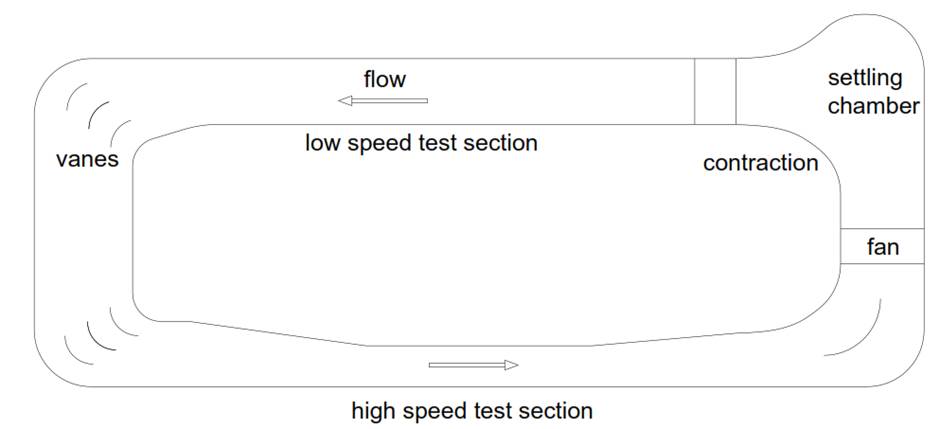Wind Testing
Wind tunnel testing is a fundamental concept in wind engineering, involving subjecting test models to controlled airflow at varying wind direction angles. However, while wind tunnels, such as Boundary Layer Laboratories (BLLs), provide valuable insights, they have inherent limitations in accurately simulating turbulence and addressing scale issues. These limitations prompt the need for a more comprehensive approach to wind testing. This page aims to highlight the significance of BLL testing while showcasing the role of the Large-Scale Open Jet (LSOJ) testing facility at LSU in bridging the gap between wind tunnel experiments and realistic full-scale outdoor testing.
Boundary Layer Laboratories (BLLs)
To simulate the lower portion of the atmospheric boundary layer extending from the Earth's surface, specialized wind tunnels known as BLLs are utilized. BLLs can be categorized as open-loop or closed-loop systems, with the latter being more energy-efficient due to recirculation of airflow. Specially designed vanes in closed-loop BLLs redirect airflow, minimizing turbulence and power loss, leading to cost-effective operations. BLLs play a crucial role in modeling straight-line winds and replicating atmospheric boundary layer profiles through passive or active management strategies. They enable wind impact studies on various structures, including buildings, bridges, towers, energy infrastructure, solar panels, wind turbines, power transmission lines and towers, wind comfort, ventilation systems, wind energy, air pollution dispersion, internal pressure studies, crosswind effects on vehicles, wind effects on sailing yachts, cable aerodynamics, and more. While wind tunnel testing provides controlled airflow for precise model testing, it faces limitations in accurately simulating turbulence and addressing scale issues found in real-world atmospheric conditions. Replicating complex turbulence patterns poses a challenge, and scaling down large structures for wind tunnel experiments can introduce uncertainties and compromise result fidelity.
 Schematic of an open-loop wind laboratory: a fan is usually located at the exit of
the test section, not to generate undesired turbulence in the flow
Schematic of an open-loop wind laboratory: a fan is usually located at the exit of
the test section, not to generate undesired turbulence in the flow

Schematic of a closed-loop BLL: closed-loop laboratories usually have at least two sections
🌬️ The Open-Jet Advantage: Pioneering Experimental Infrastructure
Conventional, closed-circuit wind tunnels can introduce undesirable "blockage effects" and struggle to achieve high Reynolds numbers, leading to scale mismatch in experimental data. The LSU WISE Open-Jet Facility is engineered to overcome these challenges, offering:
- High Reynolds Number Testing: Ensuring the experimental flow physics match those of full-scale structures, critical for accurate force and pressure measurements.
- Minimal Blockage: The open-jet configuration eliminates wall constraints, resulting in clearer, more representative measurements of structural loads.
- Customized Flow Simulation: Capability to generate specific atmospheric boundary layer (ABL) profiles that mimic the roughness and turbulence characteristics of various urban and rural terrains.
High-Fidelity Research Applications
The experimental infrastructure supports comprehensive testing across a wide spectrum of wind engineering challenges, directly informing design codes and industry best practices.
1. Resilient Infrastructure Design
We conduct detailed aerodynamic and aeroelastic testing on critical infrastructure
components to enhance performance against extreme events:
- Tall Buildings and High-Rises: Evaluating wind pressures, dynamic responses, and the effectiveness of mitigation systems like Tuned Mass Dampers (TMDs).
- Bridge Structures: Investigating wind-induced instabilities (e.g., flutter and vortex shedding) and assessing mitigation strategies.
2. Sustainable Energy Systems
Accurate wind load assessment is paramount for the viability and longevity of green
energy infrastructure:
- Solar Arrays (PV Systems): Determining critical wind uplift and drag forces on ground-mounted and roof-mounted solar panels under various terrain conditions.
- Wind Turbines: Studying complex flow interactions and aeroelastic effects on turbine blades and support structures.
3. Hazard Mitigation and Disaster Reduction
The facility is used to simulate conditions related to high-intensity wind events,
contributing directly to risk reduction:
- Tropical Cyclone and Hurricane Loads: Experimental validation of design pressures for cladding, roofing, and low-rise buildings in hurricane-prone regions.
Core Methodologies and Techniques
Our rigorous testing protocols are built on decades of expertise in fluid mechanics and structural dynamics.
- Pressure Integration Technique (PIT): Using hundreds of pressure taps to measure fluctuating surface pressures and integrate them to predict global structural response (forces and moments).
- Aeroelastic Modeling: Constructing scale models that accurately replicate the mass, stiffness, and damping characteristics of full-scale structures for dynamic response studies.
- Flow Visualization: Employing advanced laser-based systems to visualize and quantify complex flow fields around structures, providing insight into phenomena like separation and reattachment.
Selected Publications
-
Aly, A.M., Thomas, M. (2023), "Wind Induced Pressures on a Large Low-Sloped Gable Roof Building with Parapet," Architectural Science Review. https://doi.org/10.1080/00038628.2023.2174066
-
Aly, A.M., Khaled, M.F., Clancy, R. (2022), "Large-Scale Open-Jet Testing: A new frontier in structural wind Engineering," Engineering Structures, 266, 1 September 2022, 114567. https://doi.org/10.1016/j.engstruct.2022.114567
-
Aly, A.M., Chapain, S. (2022), "Large-Scale Open-Jet Testing for Cladding Design in High-Rise Buildings: Higher Peak Pressures Compared to Wind Tunnels," Practice Periodical on Structural Design and Construction, ASCE, 27(2). https://doi.org/10.1061/(ASCE)SC.1943-5576.0000689
-
Khaled, M.F., Aly, A.M. (2022), "Assessing aerodynamic loads on low-rise buildings considering Reynolds number and turbulence effects: A review," Advances in Aerodynamics, 4(24). https://doi.org/10.1186/s42774-022-00114-0
-
Aly, A.M., da Fonseca Yousef, N. (2021), "High Reynolds number aerodynamic testing of a roof with parapet," Engineering Structures 234, 1120061. https://doi.org/10.1016/j.engstruct.2021.112006
-
Aly, A.M. (2014), "Atmospheric boundary-layer simulation for the built environment: past, present and future," Building and Environment, 75, 206-221.
-
NASA, (2013), https://www.grc.nasa.gov, webage visited in October.
- Smeaton, J. (1759). On the Construction and Effects of Windmill Sails. The Philosophical Transactions of the Royal Society, 51.